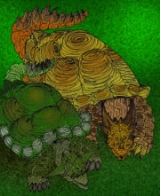
Meiolaniidae
Encyclopedia
Meiolaniidae is an extinct family of large, possibly herbivorous turtles with heavily armored heads and tails. They are best known from the last surviving genus, Meiolania
, which lived in the rainforests of Australia
from the Oligocene
until the Pleistocene
, and relict
populations that lived on Lord Howe Island
and New Caledonia
until 2000 years ago.
The family was once thought to have originated in Australia sometime in the Oligocene
, when the earliest Meiolania first appeared. However, due to the discovery of South America
n meiolaniids, including Crossochelys
in Eocene
Argentina
, and the problematic Niolamia argentina
(problematic, as researchers are unsure whether it dates from the Cretaceous, or Eocene), it is now believed that the meiolaniids appeared sometime prior to the breakup of Gondwana
during the Cretaceous.
Meiolania
Meiolania is an extinct genus of cryptodire turtle from the Oligocene to Holocene, with the last relict populations at New Caledonia which survived until 2,000 years ago....
, which lived in the rainforests of Australia
Australia
Australia , officially the Commonwealth of Australia, is a country in the Southern Hemisphere comprising the mainland of the Australian continent, the island of Tasmania, and numerous smaller islands in the Indian and Pacific Oceans. It is the world's sixth-largest country by total area...
from the Oligocene
Oligocene
The Oligocene is a geologic epoch of the Paleogene Period and extends from about 34 million to 23 million years before the present . As with other older geologic periods, the rock beds that define the period are well identified but the exact dates of the start and end of the period are slightly...
until the Pleistocene
Pleistocene
The Pleistocene is the epoch from 2,588,000 to 11,700 years BP that spans the world's recent period of repeated glaciations. The name pleistocene is derived from the Greek and ....
, and relict
Relict
A relict is a surviving remnant of a natural phenomenon.* In biology a relict is an organism that at an earlier time was abundant in a large area but now occurs at only one or a few small areas....
populations that lived on Lord Howe Island
Lord Howe Island
Lord Howe Island is an irregularly crescent-shaped volcanic remnant in the Tasman Sea between Australia and New Zealand, directly east of mainland Port Macquarie, and about from Norfolk Island. The island is about 11 km long and between 2.8 km and 0.6 km wide with an area of...
and New Caledonia
New Caledonia
New Caledonia is a special collectivity of France located in the southwest Pacific Ocean, east of Australia and about from Metropolitan France. The archipelago, part of the Melanesia subregion, includes the main island of Grande Terre, the Loyalty Islands, the Belep archipelago, the Isle of...
until 2000 years ago.
The family was once thought to have originated in Australia sometime in the Oligocene
Oligocene
The Oligocene is a geologic epoch of the Paleogene Period and extends from about 34 million to 23 million years before the present . As with other older geologic periods, the rock beds that define the period are well identified but the exact dates of the start and end of the period are slightly...
, when the earliest Meiolania first appeared. However, due to the discovery of South America
South America
South America is a continent situated in the Western Hemisphere, mostly in the Southern Hemisphere, with a relatively small portion in the Northern Hemisphere. The continent is also considered a subcontinent of the Americas. It is bordered on the west by the Pacific Ocean and on the north and east...
n meiolaniids, including Crossochelys
Crossochelys
Crossochelys is an extinct genus of South American turtle from the family Meiolaniidae. It was first named by Simpson in 1937.-External links:* at the Paleobiology Database...
in Eocene
Eocene
The Eocene Epoch, lasting from about 56 to 34 million years ago , is a major division of the geologic timescale and the second epoch of the Paleogene Period in the Cenozoic Era. The Eocene spans the time from the end of the Palaeocene Epoch to the beginning of the Oligocene Epoch. The start of the...
Argentina
Argentina
Argentina , officially the Argentine Republic , is the second largest country in South America by land area, after Brazil. It is constituted as a federation of 23 provinces and an autonomous city, Buenos Aires...
, and the problematic Niolamia argentina
Niolamia
Niolamia is an extinct genus of South American meiolaniid turtle.-Sources:* Turtles, Tortoises and Terrapins: Survivors in Armor by Ronald Orenstein...
(problematic, as researchers are unsure whether it dates from the Cretaceous, or Eocene), it is now believed that the meiolaniids appeared sometime prior to the breakup of Gondwana
Gondwana
In paleogeography, Gondwana , originally Gondwanaland, was the southernmost of two supercontinents that later became parts of the Pangaea supercontinent. It existed from approximately 510 to 180 million years ago . Gondwana is believed to have sutured between ca. 570 and 510 Mya,...
during the Cretaceous.
External links
- Meiolania platyceps Owen (The Australian MuseumAustralian MuseumThe Australian Museum is the oldest museum in Australia, with an international reputation in the fields of natural history and anthropology. It features collections of vertebrate and invertebrate zoology, as well as mineralogy, palaeontology, and anthropology...
; photo) - Mikko's Phylogeny ArchiveMikko's Phylogeny ArchiveMikko's Phylogeny Archive is an amateur paleontology website maintained by Mikko Haaramo, a student at the University of Helsinki's Department of Geology, Division of Geology and Palaeontology....
on Cryptodira - 201006 PNAS article Megafaunal meiolaniid horned turtles survived until early human settlement in Vanuatu, Southwest Pacific

